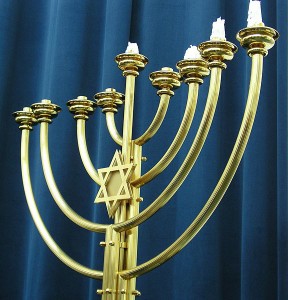By Professor Carol on Dec 05, 2015 04:00 am

Dnalor 01 (CC BY-SA 3.0)
Growing up in Roanoke, Virginia the 1950s, I never saw a menorah, at least not in my neighborhood. I also didn’t know I was Jewish.
My mother fled Brooklyn and her impoverished immigrant household in 1938 when she married a handsome, guitar-playing Gentile whose family had been dug into the West Virginia mountains for generations. She’d met him during the Depression when his family, like so many others, was thrown into New York City looking for work. I would be raised a Protestant, fully unaware of my own Jewish heritage or the existence of Hanukkah.
Hanukkah begins tomorrow, Dec. 6, at sunset. Its most important symbol appears frequently in popular culture these days. Do you remember when menorahs began to be placed routinely next to crèches in school programs or on public squares at “holiday” time? It almost seems that some people critical of Christian practice (or intent on religion-neutral civic life) welcome the Menorah a more acceptable symbol.
Anyone who thinks that doesn’t understand the Menorah.
The Menorah is a power-packed symbol of a significant event in Jewish history when the Temple in Jerusalem was restored for Jewish worship in 165 BC after a period of pagan desecration. Rebuilt after its awful initial destruction in 586 BC, the Temple had become the site of sacrifices to Zeus. Finally, the Jews, led by Judas Maccabeus, launched a rebellion and kicked out the last of the pagans. Shortly thereafter, the process of rededication (חֲנֻכָּה, Hanukkah) was undertaken.
A complex ceremony was necessary to purify the site and restore it to holiness. This ceremony commenced during Jerusalem’s winter season with what seemed an imprudent decision: sacred lamps would need to burn continuously, yet there was enough consecrated oil for only one day’s flame. Still, the first lamp was lit and, marvelously, the oil lasted through the entire eight-day period. That, at least, is the story that is told and retold through lighting the menorah.
Hanukkah became an annual Feast, although a relatively minor one by Jewish standards. Yet it was important enough that Jesus traveled to Jerusalem to take part in it, as we learn in John 10: 22-23:
Then came the Feast of Dedication at Jerusalem. It was winter, and Jesus was in the temple area walking in Solomon’s Colonnade.
A couple of years ago, I was fortunate that my work with the Smithsonian took me for the first time to Jerusalem. People always had said to me that visiting Jerusalem was a life-changing experience. They in no way exaggerated. Walking the streets of that ancient city changed my perception of so many things. Places described in the Bible went from mere names to concrete reality. I can imagine Jesus walking in Solomon’s Colonnade more easily, knowing that it happened within a few feet of where I stood discussing Jewish history with the archeologist who helped us shoot footage for our Early Sacred Music course.
Judaism and Christianity share much of the same history, but that doesn’t mean that menorahs and crèches belong side by side in Christmas displays. Hanukkah makes no sense as the Jewish version of an increasingly secularized Christmas. Quite the opposite, the Maccabees fought to preserve the integrity of Judaism against those who were trying to water it down into something more accommodating of modern trends. For Jews who remember the steadfastness of their Fathers, Hanukkah is a sacred time of quiet rededication. It, like so many Jewish holidays, has much to teach us.
Precisely for this reason, many Christians are reexamining the cornerstones of Jewish tradition. Families who never before lit a menorah are taking up the practice, or finding ways to introduce their children to the meaning of Hanukkah.
You’ll find plenty of scholarship on this issue too. Just get on line and search. You’ll also locate sources for songs, stories, recipes, and traditions of interaction during Hanukkah that can enrich every Christian’s life.
All of this would have gratified my mother, who so long ago made a rash, youthful choice that shut her completely out of her Orthodox Jewish family. Ultimately those breaches would be healed, but it took four decades before I got to know my grandmother or most of the aunts, uncles, and cousins. Perhaps that’s why I particularly rejoice in the momentum leading many Christians to understand the rituals that Jesus himself valued and practiced.
|
No comments:
Post a Comment